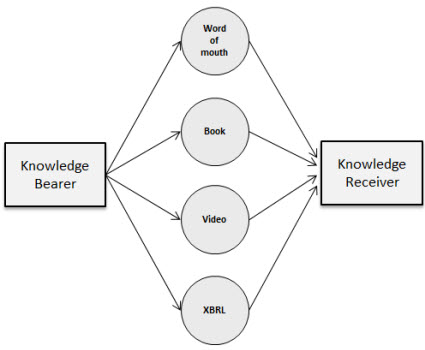Most people think about XBRL in terms of what it is. Using that definition, XBRL is a global technical syntax for exchanging information. Another way of looking at XBRL is in terms of the value it provides. Using that definition, XBRL imparts knowledge. XBRL is a new medium. XBRL is a high-fidelity knowledge media.
In his book, Systematic Introduction to Expert Systems, Frank Puppe discusses the notion of knowledge media. This figure, a modified version inspired by Frank Puppe's Figure 3.2, shows some knowledge media in order to contrast some specific advantages and disadvantages of the different media. This will help you see the value of the XBRL knowledge media:
 Inspired by Frank Puppe's Figure 3.2, page 21.
Inspired by Frank Puppe's Figure 3.2, page 21.
The graphic shows a knowledge bearer on the left which imparts some knowledge to a knowledge receiver on the right via some knowledge media. Just a few knowledge media are shown. Here is a summary of some of the advantages and disadvantages of the list of knowledge media which are shown in the graphic above:
- Direct contact between knowledge bearer and knowledge receiver: With some media you need direct contact between the bearer and receiver of knowledge. For example, with Word of mouth you generally need direct contact. With a Book, a Video, or XBRL you don't need direct contact.
- User control over information access: Word of mouth, Book, and Video all tend to be sequential access to the information. You tend to receive information in a specific order. With XBRL, it is easy to reorder or reconfigure information. The user can easily control of the order of information access.
- Verifiability of information: Verifying the information you receive is possible using any media. However, because XBRL is machine-readable; automated testing can be used to verify information and experimentation is easy. For example, I can test the complete set of XBRL-based public company financial filings using software in a matter of a few hours. Word of mouth, Book, and Video media is not machine-readable.
- Testing information ambiguity: Because XBRL is machine-readable in terms of meaning but Word of mouth is not machine-readable and Book and Video are not machine-readable in terms of meaning; XBRL can be used to measure the ambiguity of information conveyed. The effects of vagueness and poorly articulated information can be made very clear using testing, and so such ambiguity can be minimized between the knowledge receiver and knowledge bearer.
- Information fidelity: Fidelity is the degree of exactness with which something is copied or reproduced. With Word of mouth the fidelity tends to be maximized because the bearer and receiver are communicating directly. If there are issues in understanding, questions can be asked. With a Book or Video, there tends to be a bit less fidelity perhaps. With XBRL, because information is converted from what is more an analog (paper) to a digital representation, their might be a loss of fidelity if the digitization is not done well. It is sort of like the difference between a record which is analog, a CD which is digital format, and a MP3 which is compressed digital format. The price you pay for the smaller MP3 files is lost fidelity, but what is lost is the frequencies far beyond a human's ability to hear. Everything is a tradeoff.
- Reach versus richness: In their book Blown to Bits, Philip Evans and Thomas S. Wurster point out the new economics of information. In the past, you could have reach or richness, but typically not both at the same time. The internet completely changed this economic equation. Reach is access to information. Richness to quantity, timeliness, accuracy and variety of information. Word of mouth tends to be the richest information, but the reach can be lower. Books have excellent reach, but less richness. With XBRL you can have excellent reach and richness.
However, in order to make use of a knowledge media effectively, the following three conditions must be satisfied:
- Easy for knowledge bearer to represent information: The effort and difficulty required for the knowledge bearer to successfully formulate the knowledge in the medium must be as low as possible.
- Clear, consistent meaning: The meaning conveyed by the knowledge bearer to the knowledge receiver must be clear and easily followed by human beings and be consistent between different software applications. The result cannot be a "black box" or a guessing game and users of the information should not be able to derive different knowledge simply by using a different software application.
- High-quality information representation: The form in which the knowledge is represented to the receiver must be as good as possible. The quality must be high whether the knowledge receiver is a human-being or an automated machine-based process. Sigma level 6 is a good benchmark, 99.99966% accuracy.
The knowledge conveyed by a zero defect intelligent XBRL-based digital financial report as to the financial condition and financial position of an economic entity is just an example of the capabilities of the XBRL knowledge media. Digital business reports of other sorts are possible also. Think semantic spreadsheets. See here and here.